La suite GeoStudio è formata dai moduli SLOPE/W, SEEP/W, SIGMA/W, QUAKE/W, TEMP/W, CTRAN/W, AIR/W. Inoltre ora comprende anche moduli per la modellazione 3D: SLOPE3D, SEEP3D, TEMP3D, BUILD3D, CTRAN3D e AIR3D. I moduli possono essere acquistati separatamente o in bundle nella suite GeoStudio.
Adalta è Rivenditore Ufficiale e Importatore Diretto per l’Italia di Seequent GeoStudio Moduli. Richiesta quotazione…
SLOPE/W e SLOPE3D
Analisi della stabilità dei pendii
SLOPE/W è il software leader per la stabilità dei pendii in terra e in roccia, che analizza problemi semplici e complessi per una varietà di forme della superficie di slittamento, condizioni di pressione dell’acqua di poro, proprietà del terreno e condizioni di carico. SLOPE3D espande le capacità di SLOPE/W e offre un approccio pratico e sofisticato per individuare i meccanismi di cedimento dei pendii in 3D.
Grazie a questa gamma completa di funzioni, SLOPE/W e SLOPE3D possono essere utilizzati per analizzare quasi tutti i problemi di stabilità dei pendii che si incontrano nei progetti di ingegneria geotecnica, civile e mineraria.
Adalta è Rivenditore Ufficiale e Importatore Diretto per l’Italia di Seequent Slope/W e Slope3D. Richiesta quotazione…
Caratteristiche principali

Pressione osmotica dell’acqua
La Pore-water pressures può essere definita utilizzando linee piezometriche, funzioni spaziali o i risultati di altre analisi agli elementi finiti di GeoStudio. I valori possono essere visualizzati come contorni sulla geometria per rivelare i valori di PWP utilizzati nell’analisi.

Estrazione rapida
L’analisi del rapid drawdown può essere condotta utilizzando le pressioni dell’acqua di poro definite mediante le linee piezometriche, le analisi transitorie agli elementi finiti di GeoStudio o la tecnica di rapid drawdown a più stadi.

Modelli di materiali
SLOPE/W supporta un elenco completo di modelli di materiali, tra cui Mohr-Coulomb, non drenato, ad alta resistenza, impenetrabile, bilineare, resistenza anisotropa, SHANSEP, Mohr-Coulomb spaziale e altri ancora.

Progettazione allo Stato Limite
La progettazione agli stati limite o la progettazione con fattori di resistenza ai carichi viene gestita specificando fattori parziali sui carichi permanenti/variabili, sui coefficienti sismici, sulle proprietà dei materiali, sugli apporti di armatura e altro ancora.
Caratteristiche
Integrato nella suite GeoStudio
SLOPE/W è integrato nella suite GeoStudio e quindi ha accesso alle funzioni di GeoStudio per la creazione del modello, l’analisi e la visualizzazione dei risultati. SLOPE3D offre la stessa integrazione, il che significa che l’impostazione del progetto, la definizione dei materiali, le opzioni di pressione dell’acqua di poro e l’interpretazione dei risultati sono analoghi a SLOPE/W. Gli strumenti di creazione della geometria tridimensionale sono disponibili nel nuovo editor 3D di GeoStudio, anch’esso integrato nella suite GeoStudio.
Formulazione globale
SLOPE/W e SLOPE3D calcolano il fattore di sicurezza dei pendii in terra e in roccia. Possono analizzare efficacemente problemi semplici e complessi per una varietà di forme della superficie di slittamento, condizioni di pressione dell’acqua di poro, proprietà del terreno e metodi di analisi. Utilizzando il limit equilibrium, SLOPE/W e SLOPE3D possono modellare tipi di terreno eterogenei, geometrie complesse della stratigrafia e della superficie di slittamento e condizioni variabili di pressione dell’acqua di poro, utilizzando un’ampia selezione di modelli di terreno. Le analisi possono essere eseguite usando parametri di input deterministici o probabilistici in SLOPE/W. Le sollecitazioni calcolate da un’analisi delle sollecitazioni a elementi finiti 2D possono essere utilizzate in aggiunta ai calcoli di condizioni di equilibrio limite per ottenere la più completa analisi di stabilità dei pendii disponibile. Grazie a questa gamma completa di funzioni, SLOPE/W e SLOPE3D possono essere utilizzati per analizzare pressoché tutti i problemi di stabilità dei pendii che si incontrano nei progetti di ingegneria geotecnica, civile e mineraria.
Applicazioni tipiche
SLOPE/W e SLOPE3D possono modellare pressoché qualsiasi problema di stabilità, tra cui:
- Natural soil and rock slopes
- Construction excavations
- Earthen dams and levees
- Open-pit highwalls
- Reinforced earth structures
- Slope stabilization design
- Slopes with surcharge or seismic loading
- Dam stability during rapid drawdown
- Partially and totally submerged slopes
- Unsaturated slopes subjected to infiltration
- Tailings dam stability
Una scelta di molti metodi di analisi
SLOPE/W calcola le equazioni di stabilità in termini di momento e fattore di equilibrio della forza e supporta un elenco completo di metodi di equilibrio limite, tra cui Morgenstern-Price, Spencer, Bishop, Janbu e il metodo ordinario. Allo stesso modo, SLOPE3D offre la possibilità di utilizzare i metodi Morgenstern-Price, Spencer, Bishop e Janbu. Il metodo Morgenstern-Price, ad esempio, soddisfa sia l’equilibrio delle forze che quello dei momenti. Questa formulazione generale consente di calcolare facilmente il fattore di sicurezza per una varietà di metodi e di comprendere facilmente le relazioni e le differenze tra tutti i metodi.
SLOPE/W può anche eseguire analisi di stabilità e stabilità dinamica basate sulle sollecitazioni agli elementi finiti. Utilizza le sollecitazioni calcolate agli elementi finiti da SIGMA/W o QUAKE/W per calcolare un fattore di stabilità calcolando la resistenza al taglio totale e la sollecitazione di taglio mobilitata lungo l’intera superficie di scivolamento. SLOPE/W calcola poi un fattore di stabilità locale per ogni sezione.
Tecniche di ricerca di superfici di slittamento multiple
SLOPE/W e SLOPE3D offrono una serie di tecniche per la ricerca della superficie di scivolamento critica. In SLOPE/W è possibile definire le potenziali superfici di slittamento mediante una griglia di centri e linee di raggio, blocchi di punti di superficie di slittamento, intervalli di entrata e uscita o forme completamente specificate. Ciò offre la flessibilità necessaria per gestire varie modalità di cedimento, quali cedimenti rotazionali, traslazionali, compositi, retrogressivi e controllati dalla struttura. In SLOPE3D, le superfici di scorrimento possono essere definite utilizzando gli intervalli di entrata e di uscita o con l’algoritmo di ricerca naturale Cuckoo.
Algoritmo di soluzione rigoroso
SLOPE/W e SLOPE3D utilizzano un algoritmo di analisi rigoroso per affrontare problemi altamente non lineari e di difficile convergenza. La visualizzazione grafica del grafico Fattore di sicurezza vs Lambda consente all’utente di controllare visivamente l’accettabilità della convergenza per le analisi 2D, mentre il Fattore di sicurezza vs Lambda-X, il Fattore di sicurezza vs Lambda-Z e il Fattore di sicurezza vs Direzione di scorrimento sono disponibili per le analisi 3D.
Definizione completa della pressione dell’acqua di falda
Le pressioni dell’acqua interstiziale possono essere definite utilizzando linee piezometriche, funzioni spaziali o utilizzando i risultati di altre analisi agli elementi finiti di GeoStudio come SEEP/W. SEEP3D o SIGMA/W. SLOPE/W e SLOPE3D accettano anche gli approcci B-bar e Ru. I valori di pressione dell’acqua di poro definiti possono essere visualizzati come contorni sulla geometria per aiutare l’utente a vedere i valori di PWP che saranno utilizzati nell’analisi.
Rapid Drawdown Analysis
La Rapid Drawdown Analysis può essere condotta utilizzando le pressioni dell’acqua di falda definite mediante le linee piezometriche, le analisi transitorie agli elementi finiti di GeoStudio o la tecnica di rapid drawdown a più stadi. Il carico di sovraccarico dell’acqua viene calcolato automaticamente in SLOPE/W in ogni istante.
Rinforzo con ancoraggi, chiodi, pali e geosintetici
In SLOPE/W sono disponibili diverse opzioni di stabilizzazione dei pendii, come ancoraggi, chiodi, pali e geosintetici. Un tipo di rinforzo generalizzato definito dall’utente può essere utilizzato per modellare un’ampia gamma di strutture, tra cui ancoraggi o chiodi con capacità di piastra, rinforzi ancorati alle estremità e rinforzi su pali con resistenza al taglio variabile nello spazio. I carichi di armatura sono calcolati tenendo conto della capacità di trazione, dell’ancoraggio alla parete del pendio e dello stripping nella zona passiva. Ulteriori opzioni includono la dipendenza dal fattore di sicurezza, la distribuzione del carico e l’orientamento del carico. La resistenza alla trazione dei geosintetici può essere specificata o calcolata in base all’adesione dell’interfaccia e all’angolo di taglio.
I rinforzi SLOPE/W possono essere definiti automaticamente utilizzando la libreria dei fornitori, che include i prodotti di Huesker, Maccaferri, TenCate e Tensar. Questa funzionalità è stata sviluppata in collaborazione con ciascun fornitore per garantire una rappresentazione accurata dei loro prodotti.
Set di rinforzo
I Reinforcement Sets (set di armature) forniscono un comodo strumento per definire più armature in una singola analisi di stabilità 2D. Le finestre Draw Reinforcement Sets e Define Reinforcement Sets possono essere utilizzate per aggiungere, modificare o eliminare più linee di armatura che condividono le stesse proprietà di armatura. Un singolo tipo di armatura definito in Define Reinforcements può essere applicato a tutte le linee del set di armature mediante un’unica dropdown box. La spaziatura tra le linee di armatura all’interno di un set può essere basata su una distanza specificata tra le armature o su un numero specificato di armature lungo l’intervallo del set. I set di armature possono anche essere agganciati alla linea della superficie del terreno, in modo che tutte le linee rimangano sulla superficie del terreno se la geometria viene modificata.
Modelli di materiali per il suolo
SLOPE/W e SLOPE3D supportano un elenco completo di modelli di materiali del terreno, tra cui Mohr-Coulomb, non drenato, ad alta resistenza, impenetrabile, bilineare, resistenza in funzione della profondità, resistenza anisotropa, funzione generalizzata di taglio-normale, SHANSEP, Mohr-Coulomb spaziale e altri ancora.
Modelli di materiali rocciosi
I modelli di materiale Hoek-Brown e Compound Strength in SLOPE/W e SLOPE3D possono essere utilizzati per simulare i materiali rocciosi tipici. Altri modelli di materiali rocciosi tipici, come Barton e Choubey (1977) e Miller (1988), possono essere gestiti utilizzando la funzione generalizzata di taglio-normale con o senza una funzione modificatrice anisotropa.
Analisi della stabilità transitoria
La stabilità di un pendio può essere modellata nel tempo con la variabilità temporale delle pressioni e/o delle sollecitazioni dell’acqua di poro integrando SLOPE/W con uno dei prodotti agli elementi finiti di GeoStudio. Analogamente, un’analisi SLOPE3D può essere integrata con un’analisi SEEP3D per determinare l’influenza dell’infiltrazione tridimensionale delle acque sotterranee sulla stabilità nel tempo.
Progettazione allo Stato Limite
La progettazione allo stato limite o la progettazione con fattori di resistenza al carico (LRFD) possono essere gestite in SLOPE/W specificando i fattori parziali dei carichi permanenti e variabili, il peso unitario del terreno, i coefficienti sismici e la resistenza del terreno, le proprietà dei materiali e gli input delle armature. In questo modo, è possibile considerare qualsiasi codice di progettazione di tutto il mondo, come Eurocode o i British Standards.
Analisi probabilistica e di sensibilità
In SLOPE/W, l’analisi probabilistica e di sensibilità può essere condotta su quasi tutti i parametri di input e utilizzando una varietà di distribuzioni, tra cui normale, log-normale, uniforme, triangolare o una funzione generalizzata. Le correlazioni spaziali sono gestite tramite una distanza di campionamento specificata. Utilizzando un approccio Monte Carlo, SLOPE/W calcola la probabilità di guasto oltre al tradizionale fattore di sicurezza.
Pseudo-Static and Newmark Dynamic Stability
Il carico sismico può essere modellato nelle analisi di stabilità 2D utilizzando carichi sismici con varie condizioni di pressione dell’acqua di poro, tra cui il metodo della resistenza non drenata a due stadi di Duncan et al. (1990), il metodo della resistenza alle tensioni efficaci a due stadi, o anche le pressioni dinamiche dell’acqua di poro da un’analisi QUAKE/W.
Strength Reduction Stability Analysis
SLOPE/W può essere integrato con SIGMA/W per eseguire un’analisi di stabilità con riduzione della resistenza.
Facile indagine sulla geometria dei pendii
L’effetto della geometria del pendio sul fattore di sicurezza calcolato può essere facilmente analizzato in SLOPE/W creando analisi multiple nell’albero di analisi e utilizzando lo strumento Split Region.
Risoluzione rapida e in parallelo di analisi e superfici di slittamento
SLOPE/W e SLOPE3D utilizzano l’elaborazione parallela per analizzare ciascuna superficie di slittamento in modo indipendente, consentendo soluzioni più rapide su processori multi-core. Anche le analisi multiple vengono analizzate in parallelo. È possibile monitorare l’avanzamento della soluzione nella finestra del Solver Manager.
Risultati per qualsiasi superficie di slittamento
È possibile selezionare interattivamente qualsiasi superficie di scivolamento analizzata per visualizzare graficamente le forze su qualsiasi fetta o le informazioni sulla massa di slittamento. È inoltre possibile visualizzare i grafici dei risultati calcolati sulla superficie di scorrimento, come i vari parametri di resistenza o di convergenza lungo ciascuna fetta.
Risultati su più superfici di slittamento
È possibile visualizzare più superfici di slittamento sul disegno per studiare diverse modalità di cedimento e per visualizzare la variabilità del fattore di sicurezza con la posizione della superficie di slittamento. I risultati possono essere visualizzati con una mappa a colori delle superfici di scorrimento, una mappa di sicurezza o come contorni all’interno della griglia dei centri delle superfici di scorrimento. L’elenco delle superfici di slittamento può anche essere filtrato per facilitare l’interpretazione dei risultati.
Sostituzione rapida degli oggetti SLOPE/W in tutte le analisi
SLOPE/W offre uno strumento che consente di mappare gli oggetti da un’analisi a qualsiasi altra analisi SLOPE/W all’interno del progetto GeoStudio. Gli oggetti SLOPE/W vengono eliminati nelle analisi di destinazione e sostituiti con gli oggetti scelti dall’analisi corrente. Gli oggetti che possono essere sostituiti includono la linea di crepa di tensione, la definizione della superficie di slittamento, la pressione dell’acqua di poro, i carichi puntuali, i carichi di sovraccarico, i carichi di rinforzo e i carichi sismici.
Estendere SLOPE/W con Add-Ins
Scaricare e installare un Add-In per SLOPE/W per modellare un modello SHANSEP saturo-insaturo.
Soluzioni
SLOPE/W può modellare una vasta gamma di problemi di stabilità.
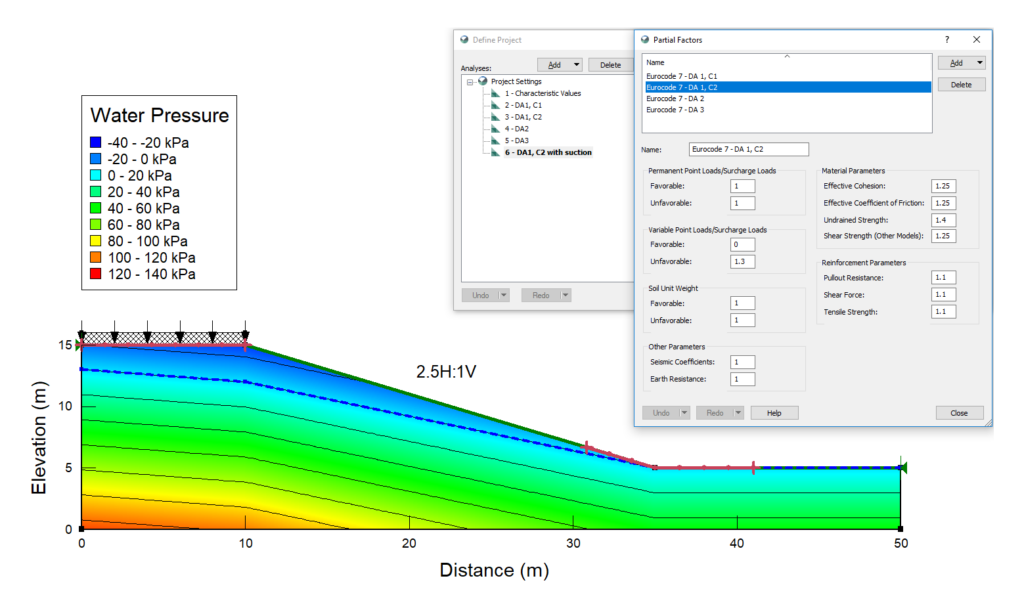
Eurocode Design Case
SLOPE/W can be used to complete a stability analysis with the objective being to check an ultimate limit state in accordance with various limit state design approaches such as Eurocode 7, Norwegian Standard NS 3480, and British Standard 8006. The stability analysis is completed with partial factors applied to characteristic loads and soil strength parameters.
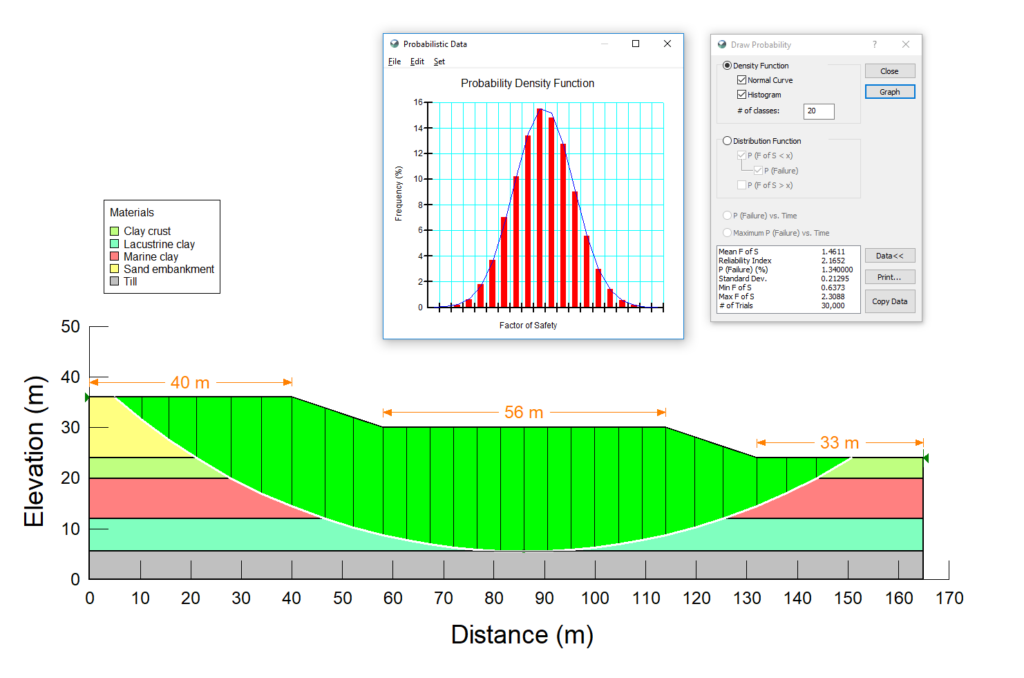
James Bay Case History
This article looks at the SLOPE/W probabilistic analysis capabilities relative to the James Bay hydroelectric project. It required the construction of fifty kilometers of dykes on soft and sensitive clay. Divergent views were prevalent regarding the selection of safety factors and strength properties. The project has consequently become an important and often-cited case history.
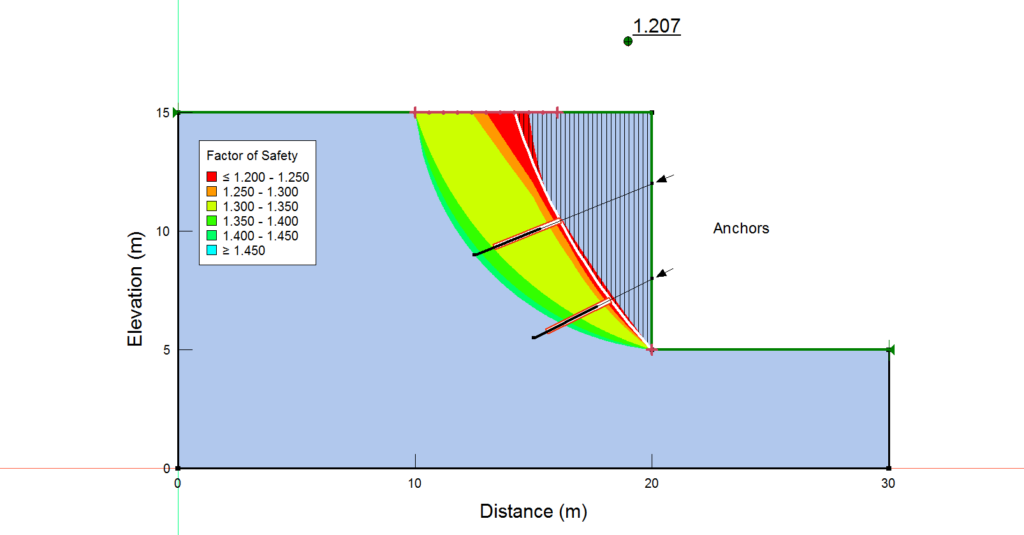
Reinforcement with Anchors
The purpose of this illustrative example is to show how anchors can be used to improve the stability of a system. Features of this simulation include: Spencer analysis method, homogenous material using the Mohr Coulomb soil model, a dry slope with no pore-water pressure, two sloping anchors, and the entry and exit slip surface option.
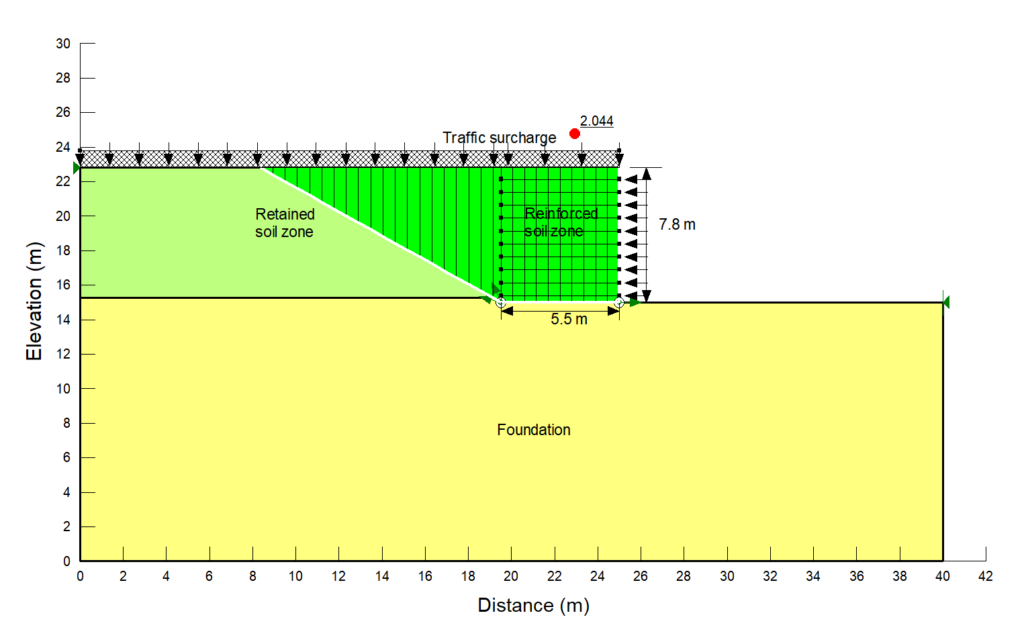
Stability of an MSE Wall
Mechanically stabilized earth (MSE) walls are structures for retaining the earth under bridges, highways, and waterfront properties, to name a few. Designing a MSE wall requires consideration of the geometric configuration and reinforcement requirement to ensure both internal and external stability.
Il flusso di lavoro intuitivo di SLOPE/W e SLOPE3D
- Creare l’area di lavoro del problema e le proprietà di analisi
- Disegnare o importare regioni del dominio da un programma CAD
- Definire le proprietà dei materiali e la pressione osmotica dell’acqua
- Definire le condizioni di carico e l’armatura
- Definire una serie di superfici di scorrimento di prova
- Risolvere le analisi
- Visualizzazione delle superfici di scorrimento calcolate come mappa a colori
- Visualizzazione dei dettagli delle superfici di scorrimento, generazione di grafici e report
SEEP/W e SEEP3D
Analisi del flusso delle acque sotterranee
SEEP/W è un potente software agli elementi finiti per la modellazione del flusso delle acque sotterranee nei mezzi porosi. SEEP/W può modellare semplici problemi di stato stazionario saturo o sofisticate analisi transitorie saturo/insaturo con accoppiamento atmosferico alla superficie del terreno.
Aggiungete SEEP3D a SEEP/W per analizzare il flusso delle acque sotterranee in 3D utilizzando lo stesso set completo di modelli di materiali e condizioni al contorno.
Adalta è Rivenditore Ufficiale e Importatore Diretto per l’Italia di Seequent SEEP/W e SEEP3D. Richiesta quotazione…
Caratteristiche principali

Condizioni limite
SEEP/W supporta una serie di opzioni di condizioni limite. È possibile inserire dati di campo o relazioni funzionali specificate dall’utente per definire gli idrogrammi, le fluttuazioni dei bacini, i cicli delle precipitazioni, gli effetti della vegetazione o le interazioni clima-terrestre.

Integrazione
L’integrazione di SEEP/W con SLOPE/W consente di analizzare la stabilità di qualsiasi sistema naturale o artificiale soggetto a variazioni transitorie della pressione osmotica dell’acqua. La combinazione perfetta di SEEP/W e SEEP3D consente di analizzare il flusso delle acque sotterranee in 2D e 3D nello stesso file di progetto.

Proprietà dei materiali
Le funzioni di conducibilità idraulica e contenuto volumetrico d’acqua possono essere stimate utilizzando le funzioni integrate. Il processo di stima richiede le sole informazioni fondamentali. È disponibile anche un modello di materiale interamente saturo.

Saturi/Insaturi
La rigorosa formulazione saturo/insaturo di SEEP/W consente di analizzare con facilità anche i problemi di flusso più impegnativi, come l’infiltrazione in un terreno asciutto o l’infiltrazione attraverso complesse dighe di contenimento degli sterili a monte.
Soluzioni
SEEP/W modella la maggior parte dei problemi delle acque sotterranee.
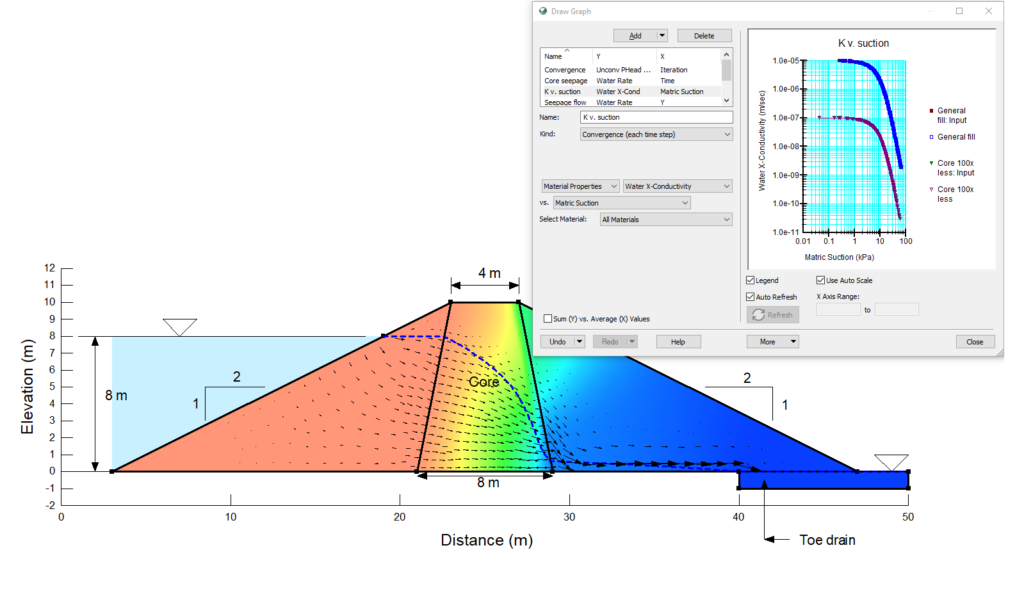
Seepage Through an Earth Dam
This example looks at a case of flow through an embankment dam. This case appears in most text books on seepage and consequently most SEEP/W users will have a good idea as to what the solution should look like. The example illustrates how easy it is to find the downstream seepage face when the dam is all one material.
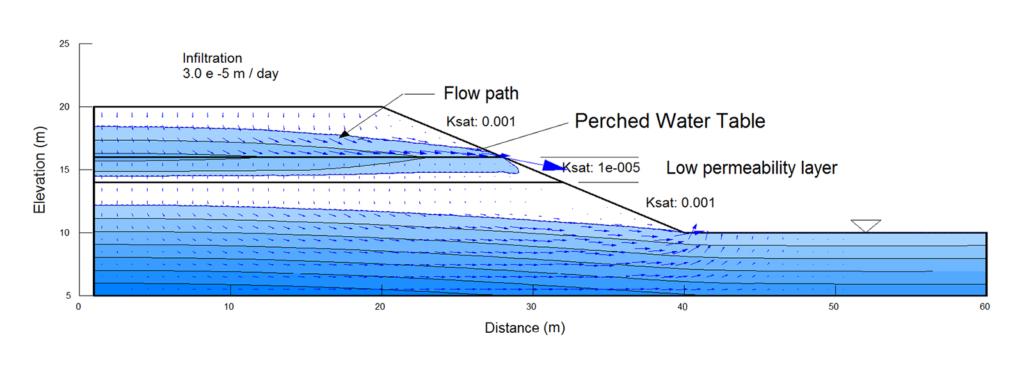
Perched Water Table
This example demonstrates how to use SEEP/W computed pore-pressures in a SLOPE/W stability analysis. The problem creates a perched watertable under long term net infiltration of precipitation. This perched condition can only be properly handled by directly using the SEEP/W results in SLOPE/W.
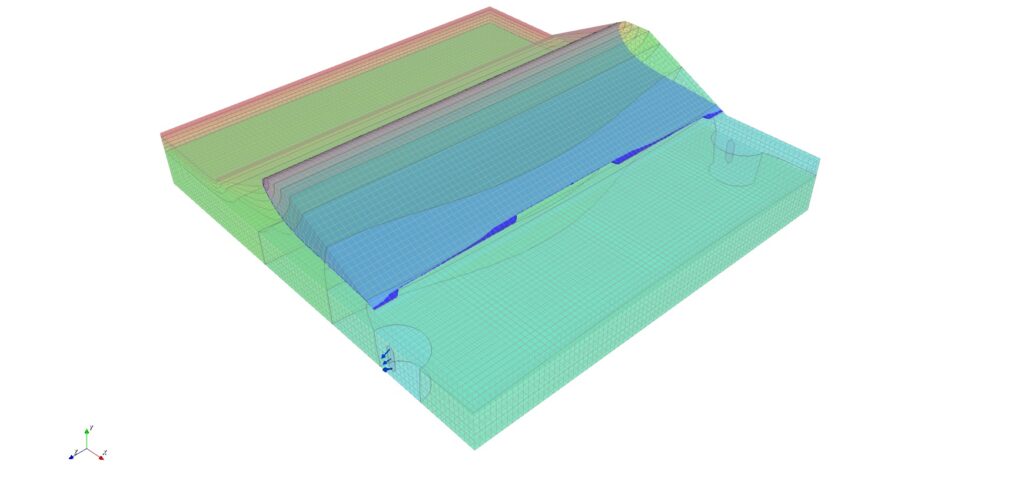
3D Relief Well Spacing
A 3D seepage analysis is required to design a relief well system, for example to alleviate excess pressure developing on the landward side of water retention dams or levees. This example demonstrates how to create and evaluate well spacing using SEEP/W and SEEP3D.
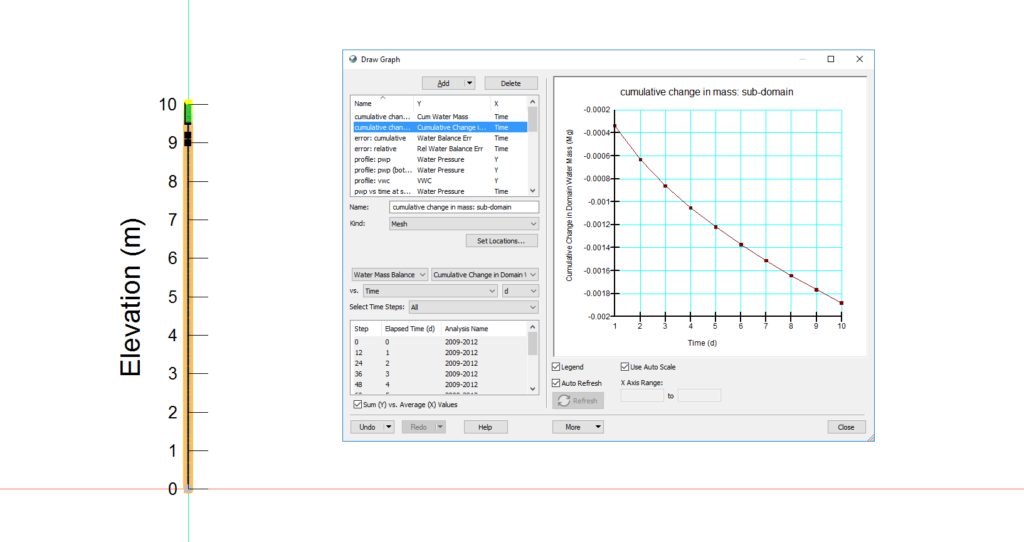
Soil Cover Modeling – Hydraulic Response
This example illustrates the basic methodology for simulating soil-climate interactions and the corresponding water flows through an engineered soil cover system placed over a waste material.
Il flusso di lavoro intuitivo di SEEP/W
- Creare l’area di lavoro del problema e le proprietà di analisi
- Disegnare o importare regioni del dominio da un programma CAD
- Definire le proprietà dei materiali e la pressione osmotica dell’acqua
- Definire le condizioni idrauliche limite
- Disegnare le proprietà della mesh
- Risolvere le analisi
- Visualizzazione delle condizioni di pressione osmotica dell’acqua calcolate
- Visualizzare le informazioni sui risultati, generare grafici e rapporti
SIGMA/W
Analisi delle sollecitazioni e delle deformazioni
SIGMA/W è un potente software agli elementi finiti per la modellazione di sollecitazioni e deformazioni in terreni, rocce e strutture. Le analisi di SIGMA/W possono spaziare da semplici simulazioni elastiche lineari a problemi di interazione di struttura del suolo con modelli di materiali non lineari.
SIGMA/W consente di analizzare un’ampia classe di problemi nei settori civile e minerario grazie alla sua vasta libreria di modelli di materiali e alla formulazione rigorosa. Con SIGMA/W è possibile analizzare complessi problemi di consolidazione, stabilità di terreni e pendii rocciosi, problemi di interazione terreno-struttura e molto altro ancora.
Adalta è Rivenditore Ufficiale e Importatore Diretto per l’Italia di Seequent SIGMA/W. Richiesta quotazione…
Caratteristiche principali

Storia dello stress
Le sollecitazioni in situ possono essere stabilite utilizzando l’attivazione gravitazionale, le sollecitazioni in campo o la procedura K0, che considera la funzione del contenuto volumetrico di acqua per determinare le sollecitazioni effettive nella zona insatura. La pressione osmotica dell’acqua può essere definita utilizzando diverse fonti.

Consolidamento accoppiato
La formulazione accoppiata di sollecitazione e pressione osmotica dell’acqua può gestire analisi complesse con terreni saturi o insaturi. Ciò è utile per le sequenze di costruzione che prevedono il posizionamento di riempimenti, lo scavo e l’interazione terreno-struttura.

Carico-Deformazione
Le attività di scarico o di carico possono essere modellate in modo semplice e accurato, compreso il posizionamento di riempimenti sommersi, la costruzione di dighe e argini di sterili, scavi profondi e la costruzione di miniere a cielo aperto. Le variazioni di pressione osmotica dell’acqua possono essere incorporate definendo le condizioni iniziali e finali dell’acqua.

Ridistribuzione dello stress
L’algoritmo di ridistribuzione delle sollecitazioni è in grado di effettuare la correzione delle sollecitazioni per qualsiasi modello di materiale con un criterio di rottura. La stabilità per riduzione della forza è disponibile anche come alternativa al metodo della stabilità all’equilibrio limite.
Soluzioni
SIGMA/W è in grado di modellare un’ampia gamma di problemi di sollecitazione o deformazione.
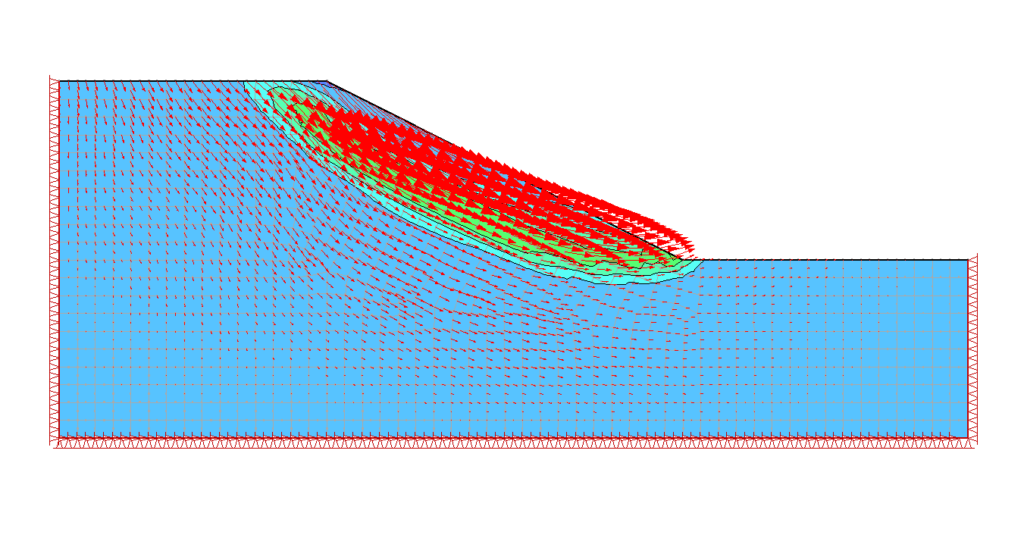
Strength Reduction Stability
This example uses the Strength Reduction Stability (SRS) technique to compute the Safety Factor for a slope. Results are compared to the Finite Element Stress stability method available in SLOPE/W.
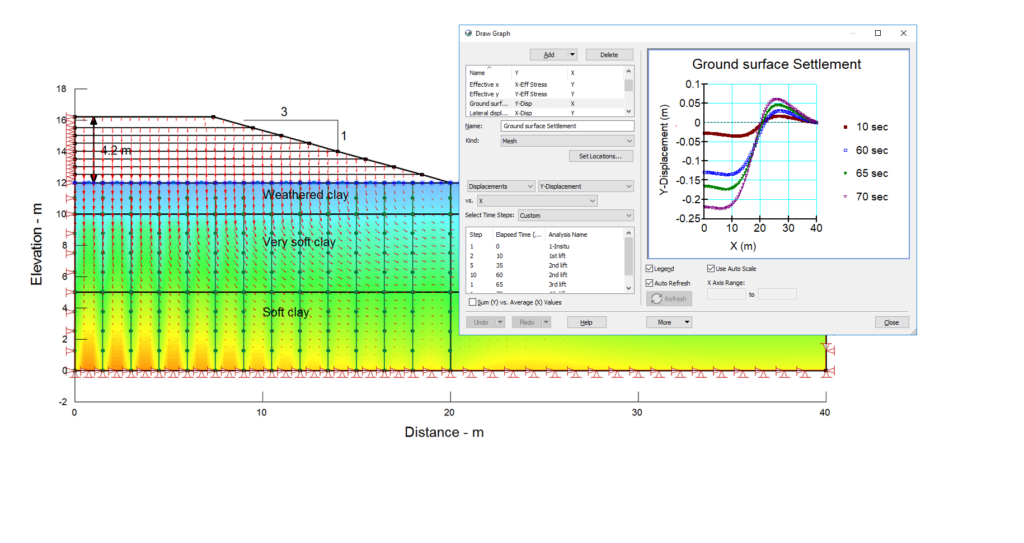
Bangkok Wick Drain
Before construction of a new airport in Bangkok, Thailand, full-scale test embankments were constructed on the site to study the effectiveness of prefabricated vertical drains (PVDs) for accelerating the consolidation and dissipation of the excess pore-pressures resulting from fill placement.
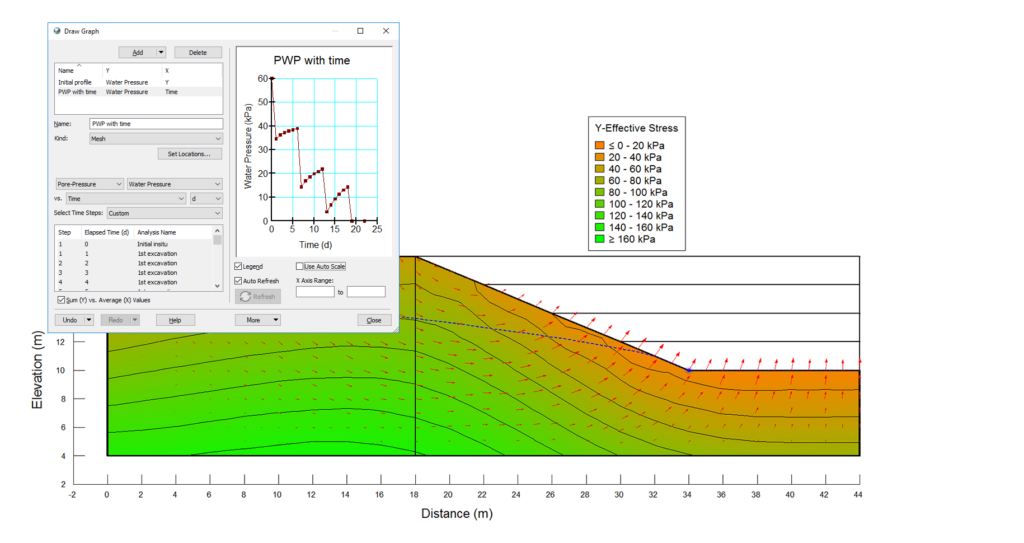
Excavation Below Watertable
The primary objective of this example is to consider the change in pore-water pressure during an excavation below the watertable, particularly the potential for negative pore-water pressures to form. A secondary objective of the example is to demonstrate the use of a moving hydraulic boundary condition on the excavation face.
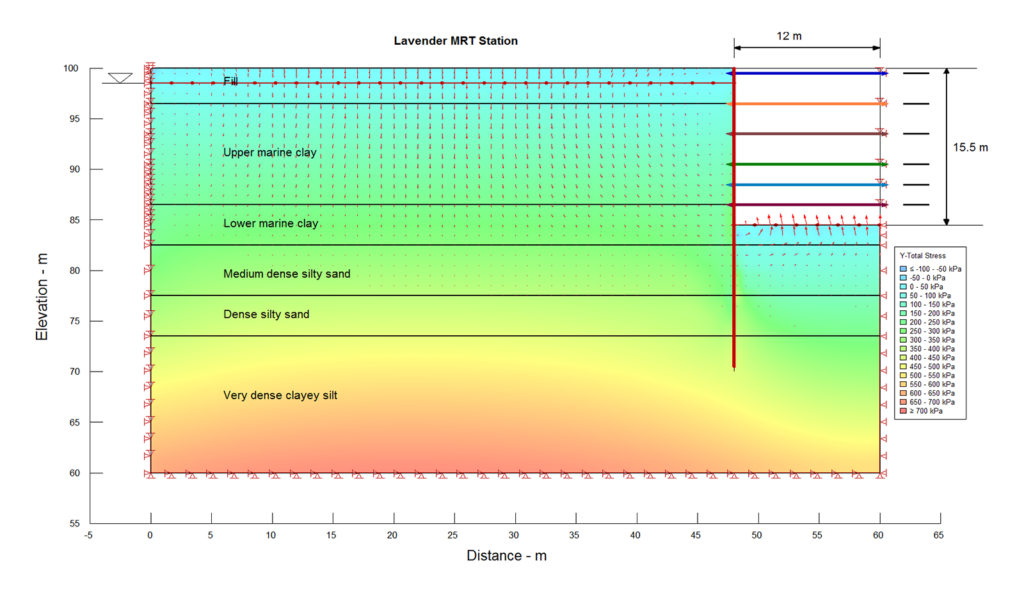
Braced Deep Excavation
Halim and Wong’s paper in Underground Singapore 2005 presents six case histories where deflections of the shoring walls were measured during construction. The case histories show that GeoStudio has the capabilities to model the behavior of deep shored excavations in soft ground.
Il flusso di lavoro intuitivo di SIGMA/W
- Creare l’area di lavoro del problema e le proprietà di analisi
- Disegnare o importare regioni del dominio da un programma CAD
- Definire le proprietà dei materiali e la pressione osmotica dell’acqua
- Definire le condizioni/strutture limite di sollecitazione/deformazione
- Disegnare le proprietà della mesh
- Solve your analyses
- Visualizzazione delle sollecitazioni, pressione osmotica dell’acqua o degli spostamenti
- Visualizzazione dei risultati, generazione di cerchi di Mohr, grafici e rapporti
QUAKE/W
Analisi dinamica dei terremoti
QUAKE/W è un potente software agli elementi finiti per la modellazione della liquefazione sismica e dei carichi dinamici. QUAKE/W determina il movimento e le pressioni in eccesso dell’acqua di falda che si generano a seguito di scosse sismiche, esplosioni o carichi d’impatto improvvisi.
Adalta è Rivenditore Ufficiale e Importatore Diretto per l’Italia di Seequent QUAKE/W. Richiesta quotazione…
Caratteristiche principali

Analisi dinamica delle sollecitazioni
QUAKE/W modella le sollecitazioni dinamiche derivanti dallo scuotimento sismico o dalle forze dinamiche puntuali di un’esplosione o di un impatto improvviso. QUAKE/W simula l’impatto di queste sollecitazioni sulle strutture terrestri.

Registrazioni di terremoti
È possibile importare i record della cronologia dei terremoti e scalarli per un’analisi dinamica. Modificare l’accelerazione di picco e la durata per garantire che i valori utilizzati nell’analisi QUAKE/W rappresentino le condizioni specifiche del sito.

Analisi Newmark
Le forze dinamiche calcolate da QUAKE/W possono essere utilizzate in SLOPE/W per calcolare le accelerazioni di snervamento e le potenziali deformazioni permanenti per ciascuna superficie di prova.

Pressione osmotica in eccesso
La pressione osmotica in eccesso calcolata da QUAKE/W insieme alle pressione osmotica statica iniziale può essere utilizzate in SLOPE/W per esaminare l’effetto dell’elevata pore-pressures sulla stabilità.
Soluzioni
QUAKE/W può modellare il comportamento dinamico di quasi tutte le strutture in terra.
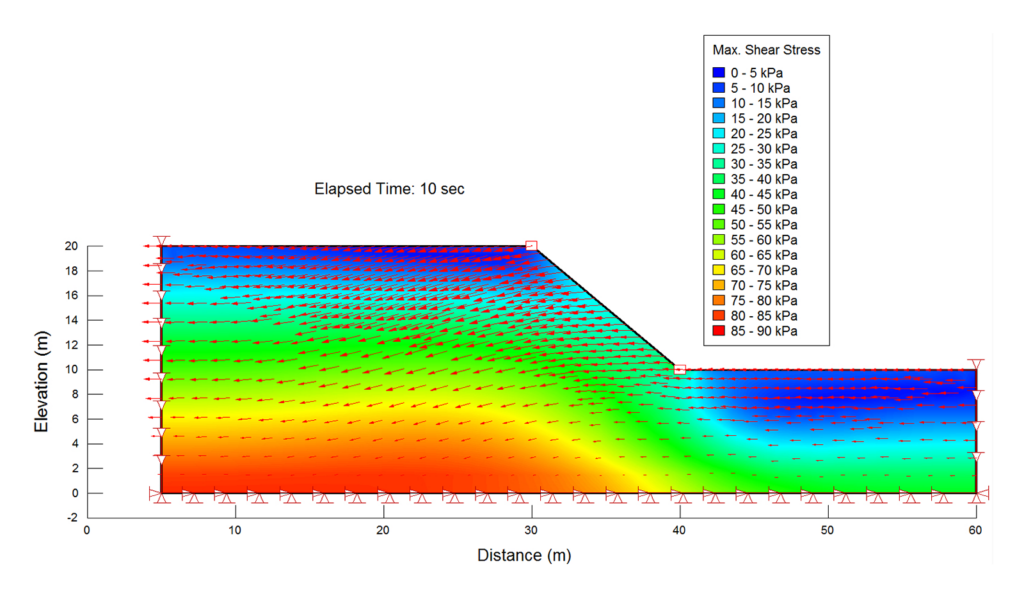
Newmark Deformations
This example demonstrates how the results of a QUAKE/W analysis can be used in conjunction with SLOPE/W to estimate the permanent deformations that may occur as a result of the inertial forces associated with an earthquake. This type of permanent deformation analysis is referred to as a Newmark analysis.
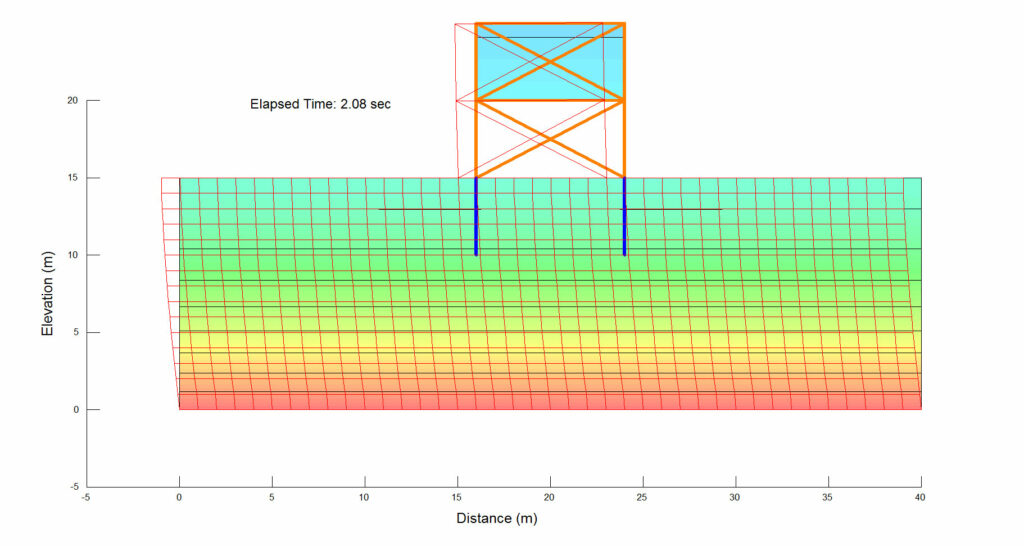
Soil-Structure Interaction
The response of the ground can be influenced by the rigidity of a structure. Stated conversely, the presence of a stiff structure could possibly affect the response of the ground to earthquake shaking. This example illustrates some modeling techniques used to include the effects of a structure, including the mass of the structure, in a QUAKE/W analysis.
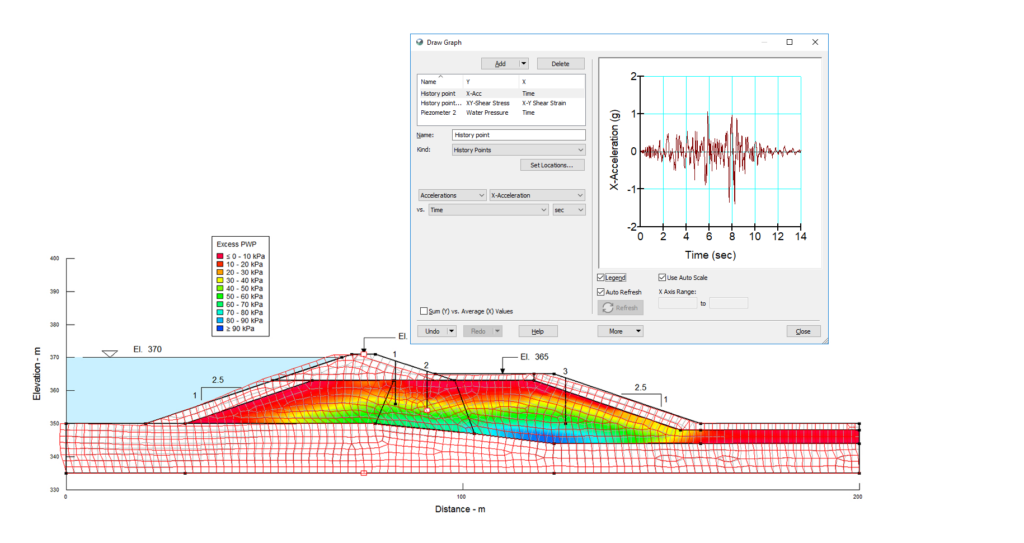
Upper San Fernando Dam
The San Fernando earthquake occurred in California in 1971. The earthquake created a liquefaction failure at the Lower San Fernando Dam and Reservoir. This analysis demonstrates the advantages of using QUAKE/W with other GeoStudio products to analyze the multiple issues that arose with this case.
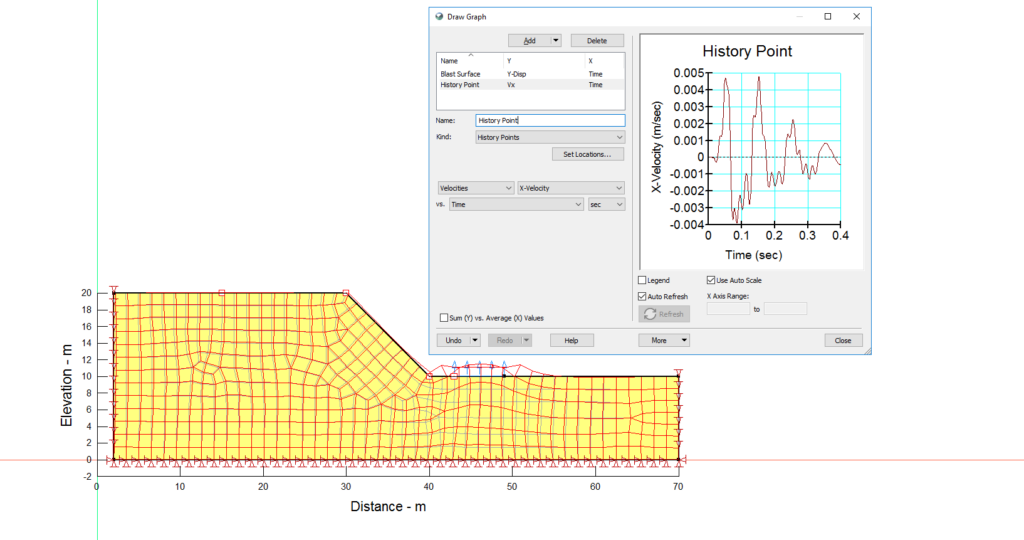
Blast Vibrations
This example considers the dynamic response of a pit slope to a blast charge. The project file contains an equivalent linear QUAKE/W analysis as well as a SLOPE/W stability analysis.
Il flusso di lavoro intuitivo di QUAKE/W
- Create problem workspace and analysis properties
- Draw domain regions or import from a CAD program
- Define material properties and pore-water pressure
- Define stress/strain boundary conditions or structures
- Draw mesh properties and history points
- Solve your analyses
- Display stress, pore-water pressure or displacement
- View results, generate Mohr Circles, plots and reports
TEMP/W e TEMP3D
Analisi del trasferimento di calore
TEMP/W è un potente software a elementi finiti per la modellazione del trasferimento di calore e dei cambiamenti di fase nei mezzi porosi. TEMP/W è in grado di analizzare da semplici problemi di conduzione a complesse simulazioni di energia superficiale con cicli di gelo e disgelo.
Aggiungete TEMP3D a TEMP/W per analizzare il trasferimento di calore in 3D utilizzando la stessa serie completa di modelli di materiali e condizioni limite.
Adalta è Rivenditore Ufficiale e Importatore Diretto per l’Italia di Seequent TEMP/W e TEMP3D. Richiesta quotazione…
Caratteristiche principali

Condizioni limite
TEMP/W e TEMP3D offrono una serie di opzioni di condizioni limite, tra cui una rigorosa condizione limite di termosifone. La condizione al contorno del trasferimento di calore convettivo consente di simulare il congelamento artificiale del terreno o altri processi che coinvolgono il flusso del fluido su una superficie delimitata.

Integrazione
Il trasferimento di calore è spesso governato dalla convezione forzata nei sistemi idrogeologici naturali. TEMP/W può essere completamente integrato con SEEP/W o AIR/W per analizzare il trasferimento di calore attraverso il flusso delle acque sotterranee o dell’aria, rispettivamente. È disponibile anche l’integrazione di TEMP3D e SEEP3D.

Proprietà dei materiali
Le funzioni termiche che definiscono le proprietà dei materiali per i terreni saturi-insaturi possono essere stimate utilizzando le funzioni incorporate. La formulazione rigorosa del cambiamento di fase fornisce una soluzione accurata ai problemi di congelamento-disgelo dei mezzi porosi saturi-insaturi.

Interezione clima terrestre
Analizzare i problemi che comportano un accoppiamento tra le condizioni climatiche e la risposta termica all’interno del terreno in TEMP/W utilizzando la condizione al contorno del bilancio energetico della superficie.
Soluzioni
TEMP/W e TEMP3D possono modellare quasi tutti i problemi geotermici.
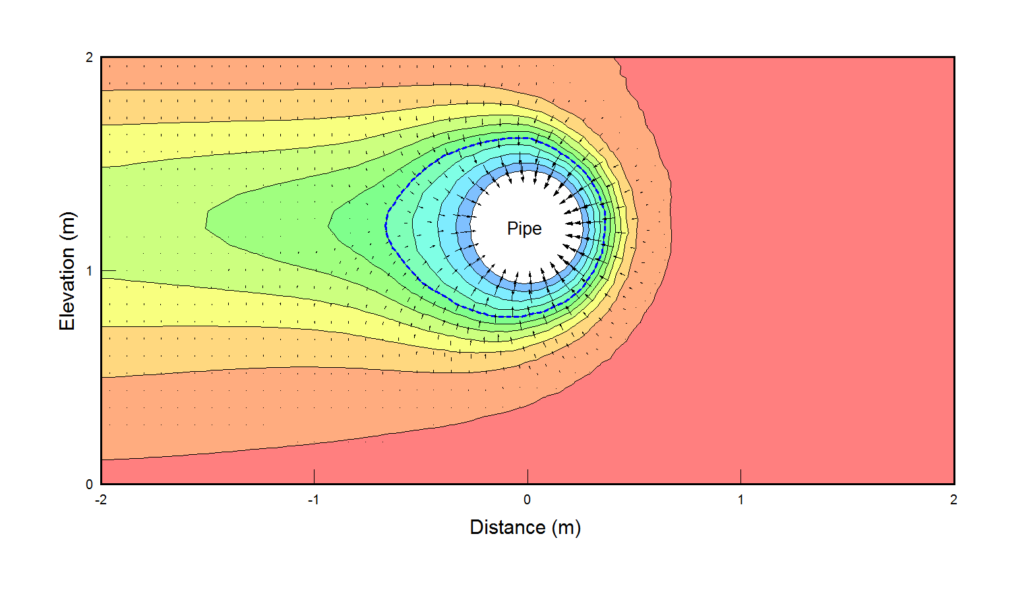
Freezing Analysis of a Buried Pipeline
TEMP/W is used to model the freezing front propagation around a pipeline. The examples demonstrates the use of circular regions and the application of the appropriate boundary conditions and material properties.
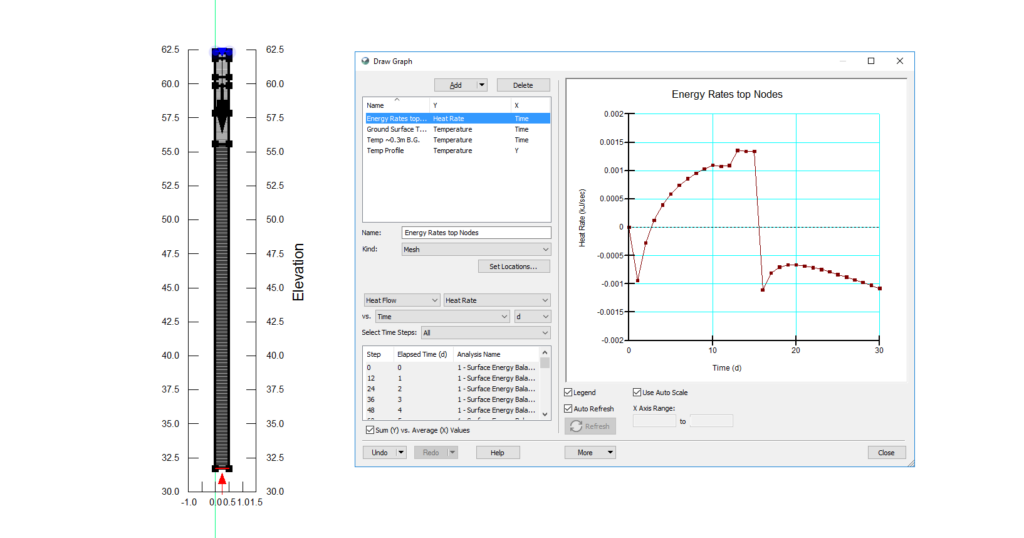
Surface Energy Balance
This example evaluates the effect of snow on the thermal response within the ground during the winter months, using the surface energy balance boundary condition in TEMP/W to simulate land-climate interactions.
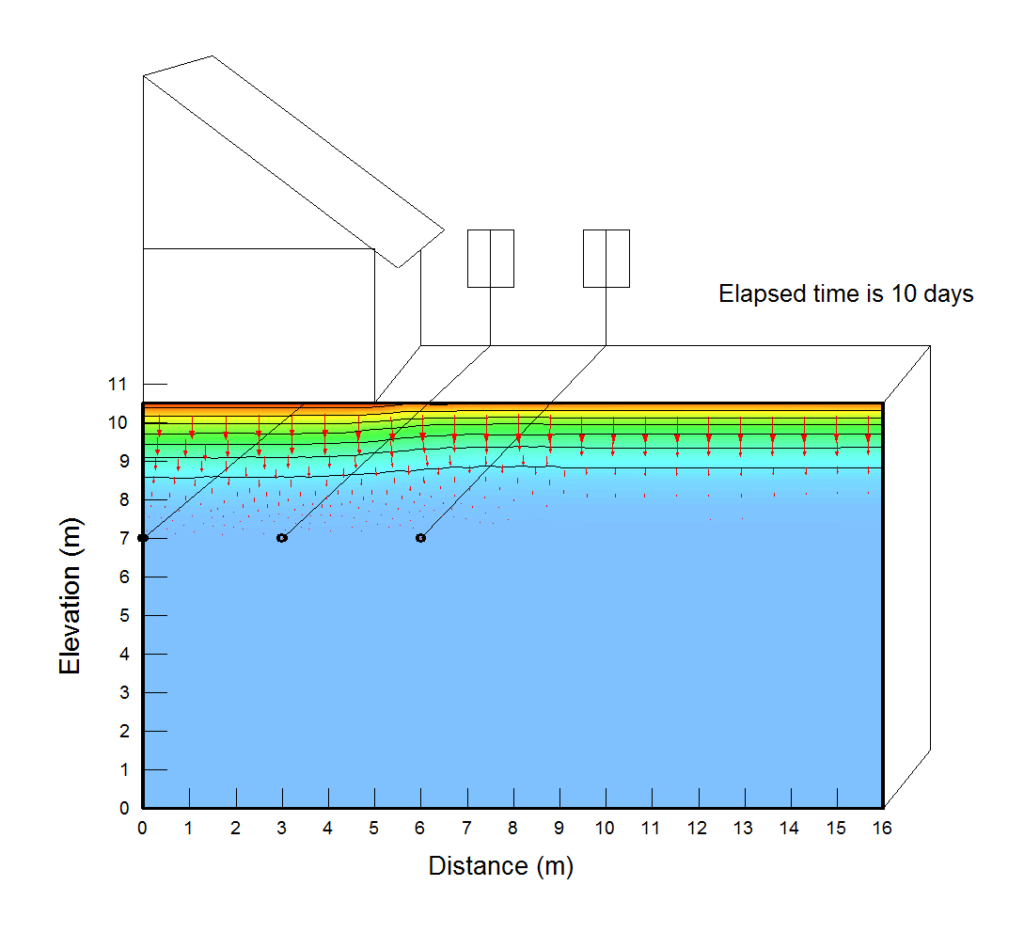
Thermosyphons
The objective of this TEMP/W example is to conduct a transient analysis of thermosyphons installed near Fairbanks, Alaska. The model is assumed to have permafrost year round at the base. A heated building rests on the ground surface.
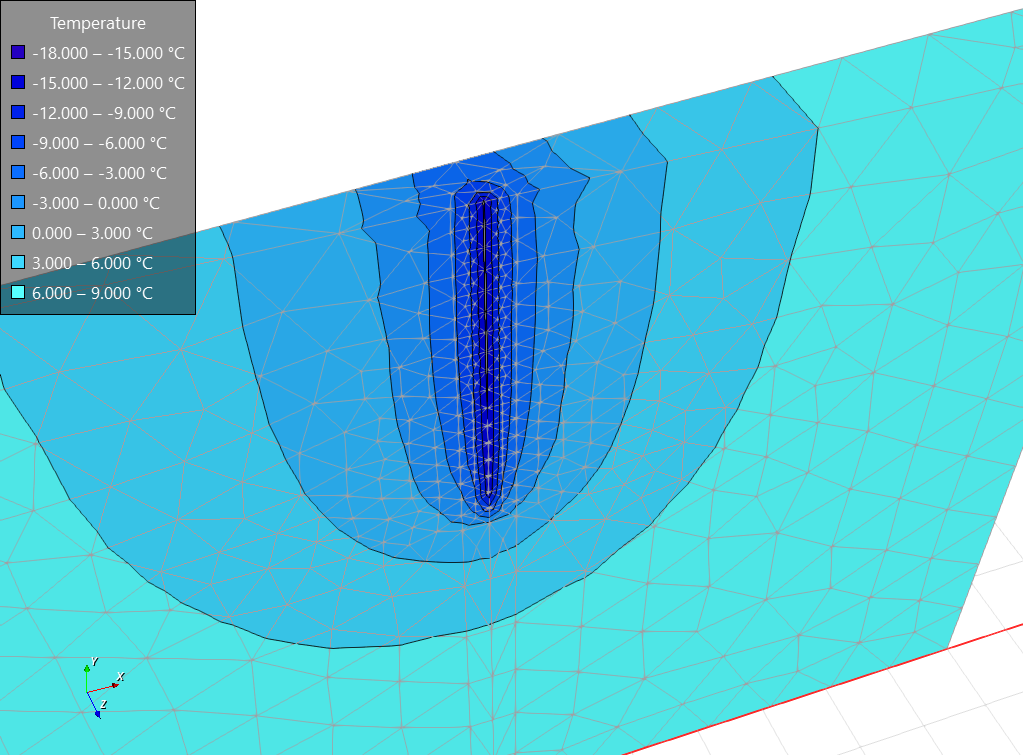
3D Mine Shaft Freezing
This example demonstrates a procedure for modeling the freeze wall growth for a mine shaft project using freeze pipes installed at equal distances around a mine shaft. Particular attention is given to the three-dimensional heat transfer at the bottom of the freeze wall.
Il flusso di lavoro intuitivo di TEMP/W
- Create problem workspace and analysis properties
- Draw or import domain regions from a CAD program
- Define material properties and initial temperature
- Define thermal boundary conditions
- Draw mesh properties
- Solve your analyses
- Display the computed thermal conditions
- View result information, generate plots and reports
CTRAN/W e CTRAN3D
Analisi del trasferimento di soluti e gas
CTRAN/W è un potente software agli elementi finiti per la modellazione del trasferimento di soluti e gas nei mezzi porosi. CTRAN/W può essere utilizzato per modellare sistemi semplici dominati dalla diffusione fino a sistemi complessi di avvezione-dispersione con reazioni del primo ordine.
Aggiungete CTRAN3D per analizzare il trasferimento di soluti e gas in 3D utilizzando lo stesso set completo di modelli di materiali e condizioni limite.
CTRAN/W e CTRAN3D possono essere utilizzati per modellare una vasta gamma di problemi geoambientali che coinvolgono il movimento di specie o gas disciolti provenienti da fonti antropiche o naturali.
Adalta è Rivenditore Ufficiale e Importatore Diretto per l’Italia di Seequent CTRAN/W e CTRAN3D. Richiesta quotazione…
Caratteristiche principali

Formulazione completa
CTRAN/W e CTRAN3D offrono la possibilità di modellare una serie di meccanismi di trasporto di soluti e gas, tra cui diffusione, avvezione, dispersione, assorbimento, decadimento e flusso dipendente dalla densità, grazie alla loro formulazione completa.

Trasferimento di gas a doppia fase
CTRAN/W e CTRAN3D modellano il trasferimento di gas sia nella fase gassosa che in quella acquosa. Per ogni fase vengono definiti un coefficiente di diffusione di massa, una dispersività longitudinale e una dispersività trasversale.

Saturi e insaturi
CTRAN/W e CTRAN3D sono formulati per il trasporto saturo e insaturo, consentendo al coefficiente di diffusione di variare con il contenuto d’acqua e al processo di avvezione di adattarsi al variare della velocità delle acque sotterranee nella zona insatura.

Assorbimento e reazioni cinetiche
CTRAN/W e CTRAN3D possono modellare l’assorbimento all’equilibrio e le reazioni del primo ordine, come il decadimento radioattivo, la biodegradazione e l’idrolisi.
Soluzioni
CTRAN/W e CTRAN3D possono modellare quasi tutti i problemi di trasporto dei contaminanti.
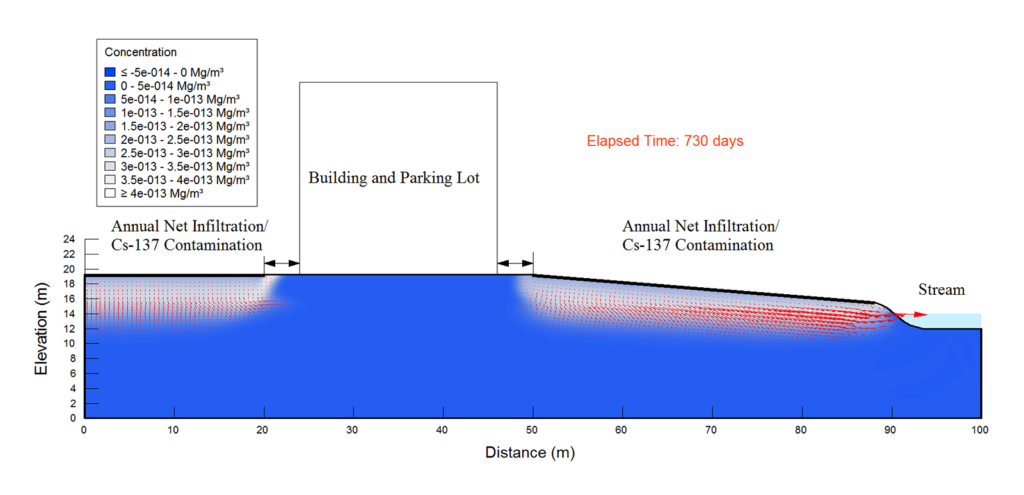
Caesium 137 Transport
Caesium-137 (Cs-137) is an anthropogenic radioactive isotope formed as a product of nuclear fission. The objective of this example is to analyze Cs-137 transport into an unconfined aquifer using CTRAN/W. The effect of adsorption and decay on solute concentrations and mass discharge is highlighted.

Transport and Consumption of Oxygen in Cover Material
The objective of this example is to analyze oxygen transport through an unsaturated cover system and explore the effectiveness of oxidation within the water retention unit.
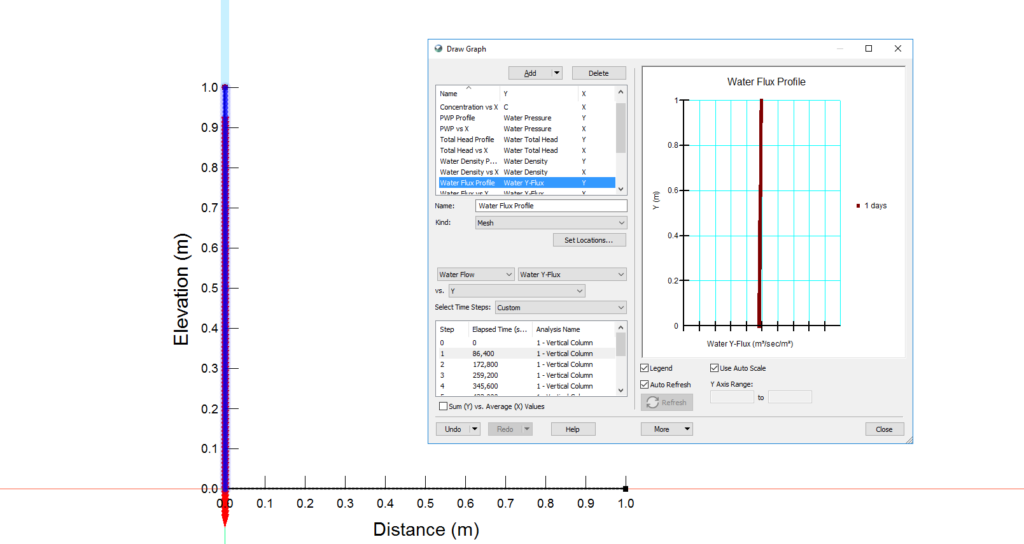
Effects of Salt Concentration on Water Flow
This example demonstrates a water transfer analysis influenced by solute concentration effects (i.e., density-dependent flow).
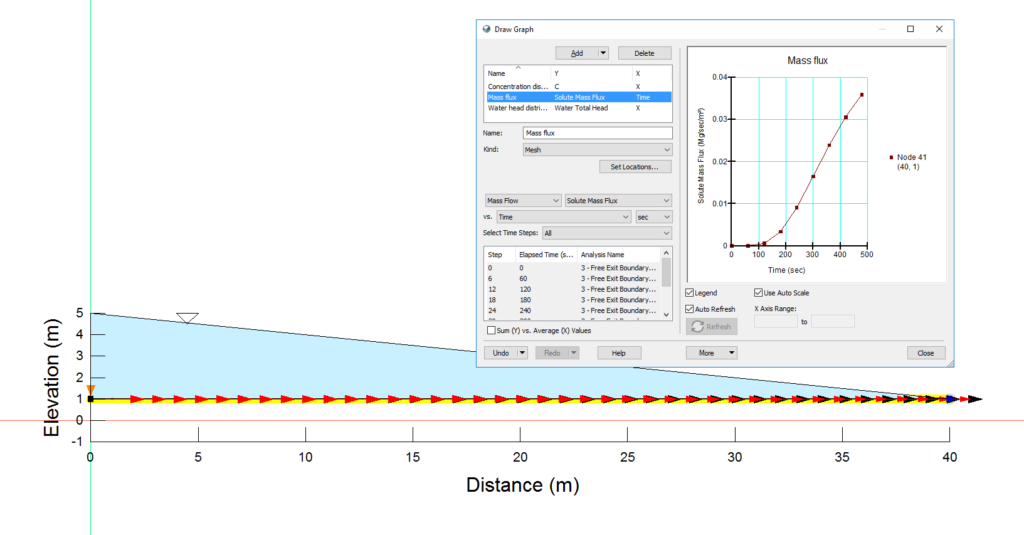
Source and Exit Boundary Conditions
This example demonstrates the use of four boundary conditions in CTRAN/W, including constant concentration, source concentration, free exit mass flux, and total mass flux of zero.
Il flusso di lavoro intuitivo di CTRAN/W
- Create problem workspace and analysis properties
- Draw or import domain regions from a CAD program
- Define material properties and initial concentration
- Define concentration boundary conditions
- Draw mesh properties
- Solve your analyses
- Display computed concentration or particle tracking
- View results, generate plots and reports
AIR/W e AIR3D
Analisi del trasferimento d’aria
AIR/W è un potente software agli elementi finiti per la modellazione del trasferimento dell’aria nei rifiuti minerari e in altri mezzi porosi. AIR/W può essere utilizzato per modellare una serie di scenari, da semplici problemi di trasferimento dell’aria in fase singola a complessi sistemi accoppiati aria-acqua.
Aggiungete AIR3D per analizzare il trasferimento dell’aria in 3D utilizzando lo stesso set completo di modelli di materiali e condizioni limite.
La vera potenza di AIR/W e AIR3D viene sbloccata quando vengono accoppiati con TEMP/W per modellare il flusso di calore a convezione forzata e il flusso d’aria dipendente dalla densità. Questo tipo di analisi è importante per studiare la chiusura delle miniere, il drenaggio delle rocce acide o il trasferimento di gas.
Adalta è Rivenditore Ufficiale e Importatore Diretto per l’Italia di Seequent AIR/W e AIR3D. Richiesta quotazione…
Caratteristiche principali

Flusso d’aria in funzione della densità
AIR/W può essere integrato con TEMP/W per modellare il trasferimento dell’aria tramite convezione libera. Il trasferimento d’aria per densità è spesso un meccanismo prevalente nei sistemi soggetti a variazioni stagionali della temperatura al suolo. È disponibile anche l’integrazione di AIR3D e TEMP3D.

Stima delle proprietà dei materiali
La funzione di conducibilità dell’aria può essere generata in base alla conducibilità dell’aria del suolo secco, a una funzione di contenuto volumetrico di acqua selezionata dall’utente e alle proprietà di base del suolo, come la classificazione del suolo o la distribuzione granulometrica.

Trasferimento del calore a convezione forzata
Combinate AIR/W o AIR3D con TEMP/W o TEMP3D per modellare il trasferimento di calore a convezione forzata. Questo processo spesso governa il regime termico dei materiali a grana grossa, come i cumuli di roccia di scarto, i rip-rap e i rilevati stratificati.

Flusso monofase o bifase
Le analisi di trasferimento dell’aria possono essere condotte utilizzando un modello di materiale monofase che considera solo la pressione e il flusso d’aria gravity-driven. In alternativa, è possibile utilizzare un modello di materiale a doppia fase, accoppiando il flusso d’aria e il trasferimento d’acqua.
Soluzioni
AIR/W e AIR3D possono modellare praticamente qualsiasi problema di trasferimento dell’aria attraverso mezzi porosi.
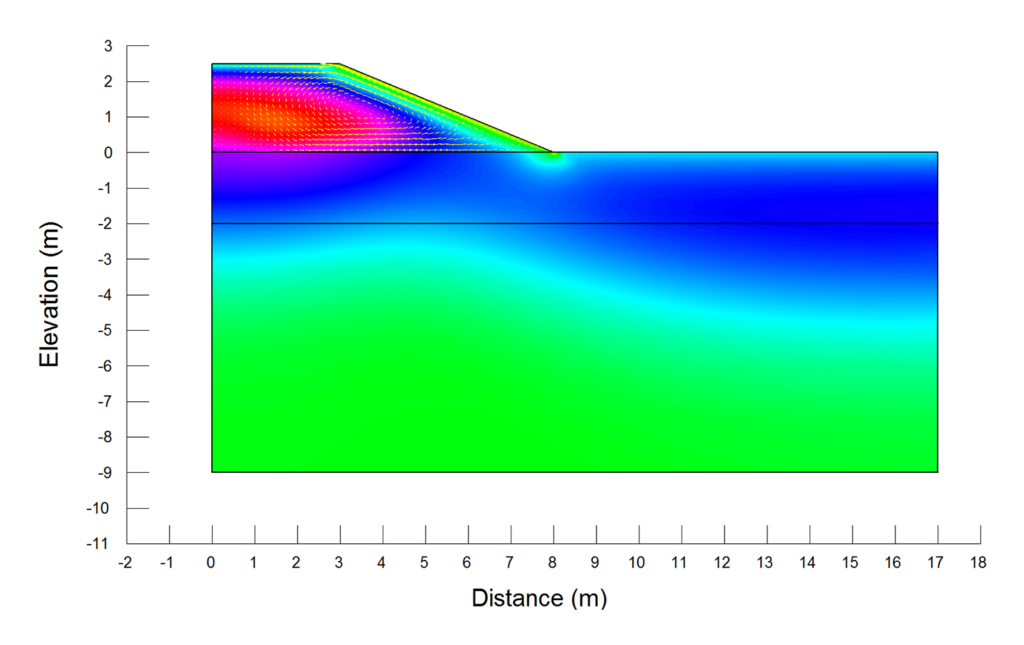
Passive Cooling
Goering (2000) investigated passive cooling within an embankment constructed of unconventional and highly porous material as a means of preserving permafrost. The objective of this example is to simulate similar convective cell behavior in AIR/W and TEMP/W as observed by Goering.
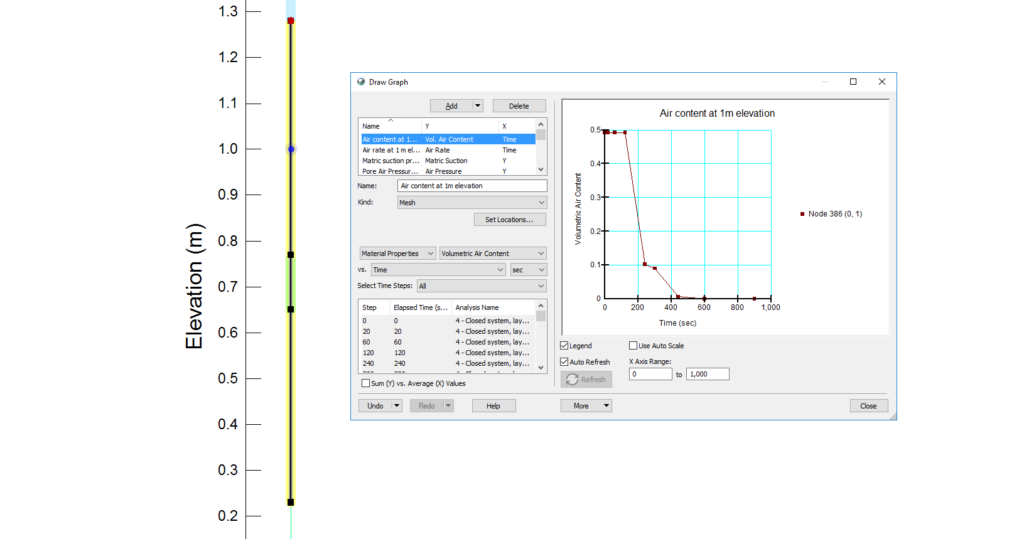
Pore-Air Entrapment During Infiltration
This example illustrates the effect of pore-air entrapment during infiltration into an unsaturated soil given a range of material properties, for both open and closed systems.
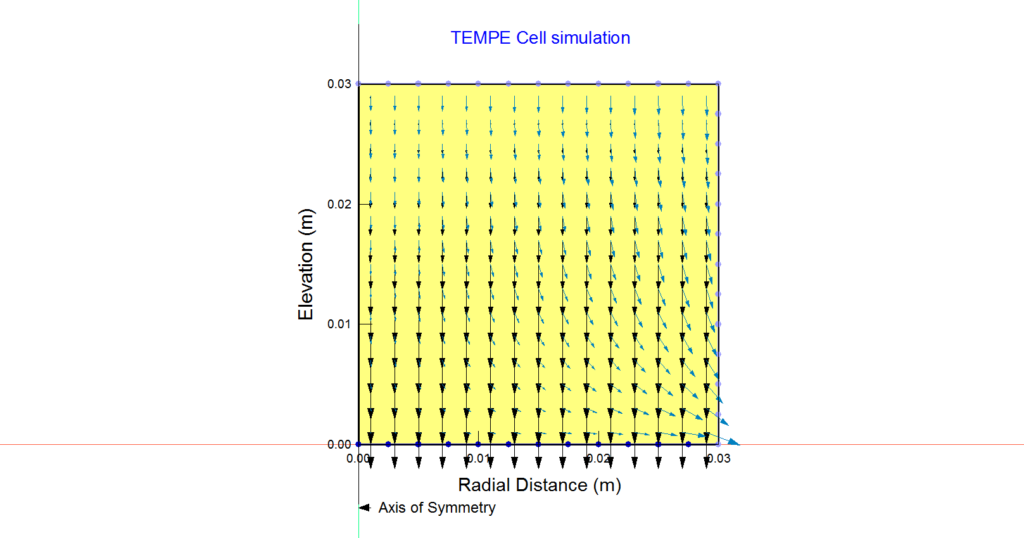
Tempe Cell Simulation
This example illustrates the ability of SEEP/W and AIR/W to simulate the results of a Tempe cell laboratory analysis for determining the volumetric water content function of a soil.
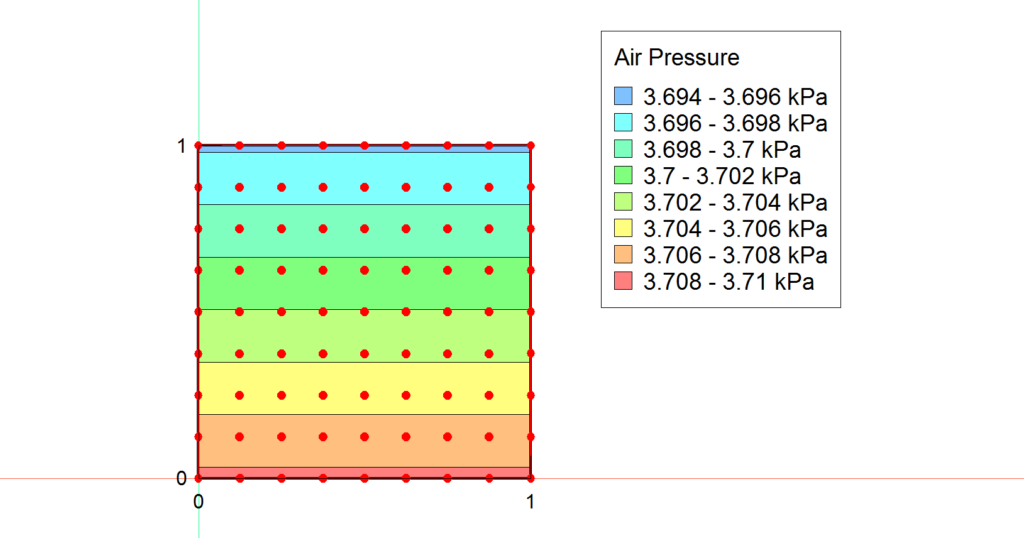
Verification – Heated Closed System
The change in pressure of a constant volume of dry air subject to an increase in temperature is simulated in this verification example. The temperature increase is simulated by TEMP/W while the air pressure response is simulated by AIR/W.
Il flusso di lavoro intuitivo di AIR/W per la modellazione
- Create problem workspace and analysis properties
- Draw or import domain regions from a CAD program
- Define material properties, pore-air pressure & air flow
- Define boundary conditions
- Draw mesh properties
- Solve your analyses
- Display computed pore-air pressure
- View results, generate plots and reports